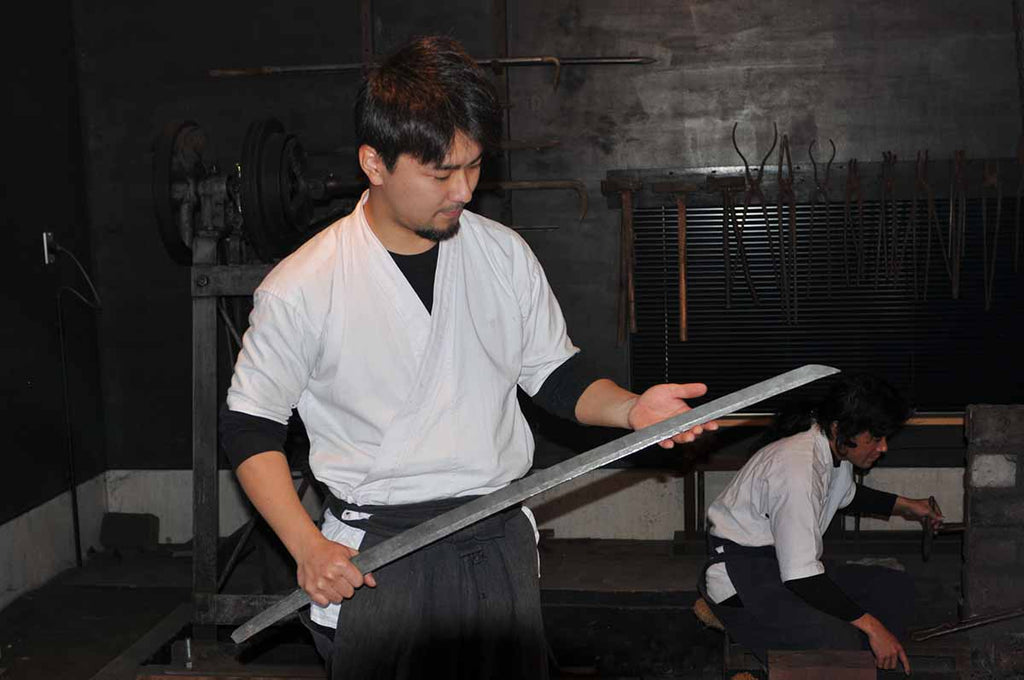A two-hour drive north of Kyoto City, Japan’s ancient capital, will bring you to the northern most part of Kyoto Prefecture which faces the Sea of Japan. Here, a small city known as Kyotango is nestled by the sea. Blessed with rich nature and delicious seafood, it is also known as a town of longevity, with approximately 2.5 times the national average of people over 100 years old living there.

It is in Kyotango City that three young swordsmiths gathered in 2019 to start a company. The company is called Nihon Genshosha and these three smiths have since devoted themselves everyday to the making of Japanese swords. The Japanese sword was once the literal and spiritual guardian of the Samurai, as well as a symbol of their elevated status in Japanese society. The goal of these smiths is to restore this value of the Japanese sword. It is no wonder that they chose the Tango region, with its ancient iron manufacturing sites and a long history with Japanese iron.

The three smiths of Nihon Genshosha are Tomoki Kuromoto, Tomoyuki Miyagi, and Kosuke Yamazoe. Gen generally means “black.” However, it also means “deep and profound reason.” It is a word that truly represents sword smithing. Sho means “to carry on,” and the name of the company is an expression of their commitment to carry on the art of sword making and pass it on to future generations.
All three learned the art of sword-making from the same master, Yoshindo Yoshiwara. Yoshihara, who has been prestigiously nominated three times for the sacred sword of the Ise Shrine within Japan, has also been made an honorary citizen of Dallas, Texas, and has even had the Metropolitan Museum of Art and the Museum of Fine Arts, Boston, go out of their way to purchase his swords for display.

When we first arrived in Kyotango, we found a showroom on a small hill where swords and tsuba were on display. The interior was a traditional Japanese house remodeled with a modern twist and sporting a stylish atmosphere while also maintaining a hint of nostalgia within a room gently lit by warm natural light. On the left side of the building, there was the blacksmith workshop with warding, and inside we found yet another unique and mysterious atmosphere.


While visiting, I was given the chance to experience first-hand striking the hammer on red hot tamahagane steel. The moment I took the large mallet in hand, I was taken aback by the weight. "I can't believe I'm hitting with such a heavy thing," I thought. Then, sitting firmly, I struck the small burning tamahagane. The numbing impact of striking the iron propagated throughout my body, which was simultaneously being subjected to the intense heat of the heated steel and the furnace.

Thinking of how many times this process had to be repeated to create the kawagane and shingane that characterize Japanese swords, I was again amazed at the mind-boggling process that goes into the making of a Japanese sword. Just a few minutes of swinging the mallet and I had already broken a sweat. During that short time, however, I felt as if I had entered a zone; a feeling of fulfillment that is hard to describe.

Afterwards, I asked about how they had all come to be apprentices of Yoshindo Yoshiwara. Initially, they explained, they had been refused entry into the school. Even though they had requested to become his apprentice, they were told to finish high school or college first, instead of quitting to become an apprentice. This is because becoming a swordsmith is not just about honing one's skills as a craftsman, but because becoming a swordsmith meant that one needed to have a variety of experiences in life in order to develop the ability to self-produce and market one's own creations.

Furthermore, even if they did become swordsmiths, it was not guaranteed that they would be able to make a living by making swords. This lesson led the three to spend many days and nights thoroughly discussing what kind of swordsmith they should become once they moved out to forge their own path. The final result was the establishment of a company by the three swordsmiths - a rarity in Japan.
These three are concerned that the tradition, culture, and techniques of making genuine Japanese swords in Japan are dying out, and that there are swords on the market that are only imitations of the original shape and not made in the original way. For this reason, they want to further polish their sword-making skills, preserve this tradition for future generations, and communicate the value of the culture of Japanese swords to the world. The fire in their eyes as they spoke with us burned just as fiercely as the forge that tempers their blades.

These young smiths are definitely not to be overlooked.
Also, check the following;

Want to buy authentic Samurai swords directly from Japan? Then TOZANDO is your best partner!

3 comments
Mar 04, 2025 • Posted by Tozando Katana Shop
Thanks for the comment. They were very enthusiastic and promising young swordsmiths. If you ever come to Kyoto, please visit them.
Mar 10, 2023 • Posted by Romel villar
I will visit japan and make business with your company
Mar 10, 2023 • Posted by Romel villar
I will visit japan and make business with your company
Leave a comment: